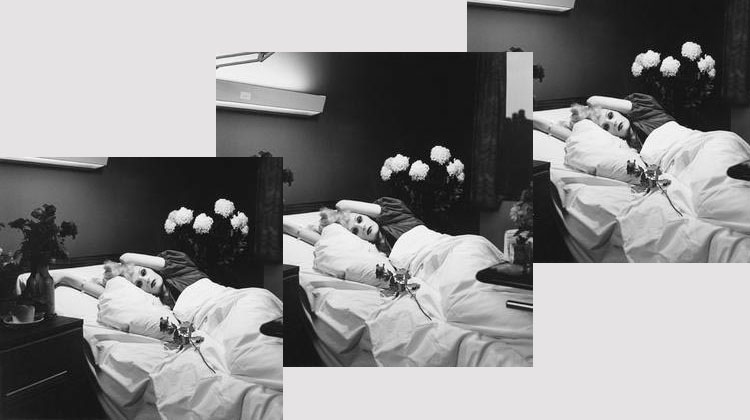
I have a Google Drive folder full of things people say Candy said before she died. I have a 66-page book filled with the names of trans people who were killed last year. Almost every source filed in my folder includes Candy’s birth name. In the book of the dead many of the people are named unnamed.
Candy Darling is dead, and I’ve only known her dead, and I mourn her anyway. She is not the first trans person I’ve mourned without meeting, and she won’t be the last. How many ways would the world need to change for me to mourn less? I’ve stopped buying prayer candles because they burn down faster than I can pray. Now, they line my walls, empty, next to all the clutter I’ve inherited from younger mes, and lovers, and friends, waiting for me to put something in them that feels okay. I won’t throw them away.
In March, I travel to New York City on an overnight bus; a trip I tell people is “to write and do research for my thesis,” but is really to get the fuck out of my bed and the midwest cold which confines me there. I love the overnight bus—love how no-nonsense it is, that there is only one random stop in Pennsylvania at whichever truck stop the driver feels like stopping at, that nobody cares enough to steal your shit, and that the bus arrives in NYC just at dawn: the city pink and tall around you before the skyline even becomes clear. On this trip, I buy sloth-shaped gummies at the truck stop (not sour enough, 5/10 do not recommend) and decide that, since my seat-mate and I have been touching at the hip the whole ride, we are probably meant to be together forever.
What I really love, though, is being my own best date—walking for miles and miles by myself, stopping to read, or smoke, or eat when I feel like it; bringing myself to parks and museums; listening to podcasts or music while I wander. My friends in New York have known me almost as long as I’ve known myself, and they don’t make me spend any time with them when I visit. I do spend time with them—but I linger in my own company longer, holding close the hours where I don’t speak a single word.
On the Chelsea High Line, I trace the railroad tracks one shoe at a time, throwing my arms out to balance myself like a kid in an old-timey baseball movie. The sun is fresh against my face, and I feel like a Very Fashionable New Yorker with my outfit of three-linen-layers-plus-a-menthol. It is golden hour in all directions, and the bees have come to inhabit the gardens on the line. I am walking to the Whitney on their pay what you want admission night, to search for Candy Darling in the three-story Andy Warhol retrospective exhibit.
“Real alternatives differing from those offered by the System are only possible if one of two requirements is fulfilled: making films that the System cannot assimilate and which are foreign to its needs, or making films that directly and explicitly set out to fight the System. Neither of these requirements fits within the alternatives that are still offered by the second cinema, but they can be found in the revolutionary opening towards a cinema outside and against the System, in a cinema of liberation: the third cinema.”
— “Towards a Third Cinema,” Fernando Solanas and Octavio Getino
The Third Cinema asks: can art be made without the steady, prodding hand of the State taking it for its own? And answers yes. What conviction! What hope! I’m thrilled by the idea that cinema—or any art—can be made which “directly and explicitly [sets] out to fight the System.” But it’s hard for me to believe that any thing is foreign enough that the State can’t swallow it whole. After Robert Cohen photographed Edward Crawford throwing a tear gas canister back towards the cops who shot it in Ferguson, Pepsi swapped the throw for a handshake, and can for a soda, and made a commercial. And Edward Crawford turned up dead. Killed, I mean. Vanity Fair put Caitlyn Jenner on their cover to sell her and her embodied capital 1.2 million times, at the expense of trans women who aren’t white and rich and Republican, and who don’t get a million-dollar makeover. Tourmaline Gosset poured through archives of her trans elders, and then a cis man stole that story for profit.
This is not to say I don’t believe art matters—what can exist which doesn’t? But at my best I can only imagine art as tangential to action, the afterimage of liberation. Still, I turn to anything which tells me that I’m wrong and bury myself in it. I try to slip myself past the art and into meaning when I can.
In the Whitney, I push past crowds to jump in and out of each gallery room, searching for some documentation of the Candy Darling Andy Warhol documented. Warhol was a fucking snake. Do I get to say that? Do I, when I know, can feel, the collection of trans people—mostly women—he fed and kept on his glittery factory walls? Did you know that, while rejecting Candy, he once said that he wanted to use “real women” instead of “chicks with dicks”? And yet I do not fault his collected performers for being near him. Warhol was/is security—a meal and roof when there was no meal and roof. How can I fault the pursuit of that?
Before I find Candy, I see Warhol’s large painting of Marsha P. Johnson—one of the many pop art pieces he made in an attempt to capture the people around him. It’s in the same room as a wall-size mural of Mao Tse Tung, a curatorial recreation of Warhol’s silk print of the same subject. Marsha’s painting is on the opposite wall, the one wall in the room which has stayed white. I say “Marsha’s painting,” but I’m not sure we could really call it that—it’s a painting made from polaroids Warhol took, a singular captured moment in Marsha’s life, a life which Warhol wasn’t there for. I dislike the painting; how it brushes over Marsha’s eyes with messy blue paint and contorts her smile into a grimace.
I was not present for Marsha’s life either. Still, I know: there are no flowers here, where there should be flowers.

as cover photo for I Am a Bird Now / Wikipedia
In Peter Hujar’s photograph, “Candy Darling on Her Death Bed,” Candy reclines in her hospital bed, her head cradled by an outstretched arm. In this work, flowers are everywhere: a rose in front of her on the bed, mirroring her pose; white hydrangeas standing up in a vase behind her; and blurred remnants of flowers at the edges of the frame. But it is Candy’s eyes that interest me the most: darkened by makeup into hazy marquise cuts, and haloed by her arched brows, I can’t see her pupils. No matter how closely I look, peering past medical artifacts, beautified by the camera’s lens, I do not know if Candy is looking back at me.
Anyway: I don’t want to tell you about how good the photograph is, how technically perfect. I want to tell you that Candy invited Hujar there, and that she asked him to take her photo, for her “fans,” and I want to believe it. I want to believe that the flowers laid around her face were there before Hujar arrived, and that they stayed when he left. I want to believe that Candy directed every little thing about that photo, and that she dreamed it onto gallery walls. I want to believe that every single person who looks at Candy’s photos is her “fan.” I want to believe that when I gaze into her eyes on the wall, she meant for me to gaze.
How do we excavate meaning from mediated art? How many layers of rock must we remove to get to something real? And how can I tell you that my hands are still dirty from the excavation?
My god, for once, could we just let the woman speak? And god, please, can I want for her to speak without wanting her to also wash the grime from my hands?
“When Warhol made his film Heat in 1972, he did not invite Darling to play any role, which left her devastated. Two years later, Darling was diagnosed with lymphoma. Those close to her suspect it was caused by the hormones she took to grow breasts—at Warhol’s suggestion. In the ultimate tragedy, it may have been her effort to transform into what she believed was her true self that killed her. As she faced the last days of her life, she received one final, perfect tribute in the photograph, Candy Darling On Her Deathbed (1973) by her friend Peter Hujar. Fran Lebowitz—a friend of both Darling and Hujar—recalled the day they visited Darling in the hospital, and that she was too scared to see her friend so close to death, let alone photograph her. But Hujar was uniquely suited for the act because he had an innate understanding and appreciation for subjects in liminal states of contradiction.”
— “Candy Says: Remembering Two Artists and One Image,” Amelia Rina
When I see Hujar’s portrait in person for the first time, the first thing I notice is my own reflection, mirrored by the glass reflecting Hujar’s silver gelatin. I cannot confront Candy without confronting myself.
The photo obscures as much as it reveals. It doesn’t predict Hujar’s death, fourteen years later, nor does it show the tension where their deaths intersect—discarded in the wake of political persecution, Candy killed by desperation for hormonal treatment, Hujar by AIDS. There is no suggestion of how long the photo will survive Candy—that it will become Hujar’s most widely distributed image.
And the picture obscures much about Candy’s life in its filmy glamour: her fight to be taken seriously as an actress; meals found through the whims of monied men; the noose hung around her neck in elementary school; the years of vocal training she underwent to sound like a breathy girl; the times she made it and the times she didn’t. Candy’s life, as all of our lives, was messily entangled with the power structures that determine our level of risk in the world, and with the choices she made in navigation. Who can represent that in an image? And if it was represented, could it be reproduced in truth?
I do find Candy Darling in the Whitney—in the same room as the Marsha P. Johnson portrait. There is a small t.v. playing some of the short, candid videos Warhol made in The Factory, and Candy is present in one. In the video, Candy, Warhol, and a few others banter, wandering in and out of the frame. There’s a couch, and, sometimes, someone will flop into it, but they never seem to stay.
The video quality is degraded, and it’s difficult for me to tell who is who. But I do recognize Candy—she’s unmistakable in her tall glamour. While the camera focuses, and unfocuses, and while I sway on my feet, struggling to stay standing in one spot for long enough to finish the whole thing, Candy dances in the screen, holding some type of big stick—maybe a broom handle? Perhaps a leftover piece of pvc pipe? She looks out of place in the scene, like she’s dreaming in front of everybody else.
There is something distinctly animated about Candy Darling, something which moves me. She is licking a lollipop as she dances, moving it around in her mouth, like a baseball player might chew gum, or a baby might suck on a pacifier. She is blurred and unblurred in my eyes; as Rina says, she is a star in a liminal state of contradiction.
Before I walk away, Candy turns to face the camera. How was that? she asks.
I am not attempting to say that all art made by or about a trans person is radical—it just isn’t. And the history of trans performance is rife with racism. Candy, herself, appeared in blackface in the 1972 film The Death of Maria Malibran. There is little written about this specific performance of Candy’s, though I did find a tumblr page called: “Why, Candy, Why?” It’s the question asked so often of deceased white artists—why did you do that thing? Why did you say what you said? Concealed between those questions, I think, is this: a desire to escape confrontation with white supremacy, and to be able to shrug off recognition of complicity. You know: why can’t anybody just like something anymore? Does it always have to be such a big deal?
Perhaps that desire clings to the idea that, eventually, we can find just one white person outside of white supremacy, and all be absolved.
So many histories are here to unpack: the co-creation of Blackness and transness in slave-holding, colonial America; the intersections between minstrelsy and comedic cross-dressing meant to shame and humiliate; lines between minstrel and camp aesthetics; current appropriation of Black and Latinx cultures in drag; the violent blur between all of these things. In his book Black on Both Sides, Dr. C. Riley Snorton says, while talking about “fugitive theater,” that the “ungendering of blackness…opens a way of thinking about black gender as an infinite set of proliferative, constantly revisable reiterations figured ‘outside’ of gender’s established and establishing symbolic order.” In other words: Black gender should be something that the system cannot assimilate. But, somehow, it does: Candy performs in blackface and is only why’d in passing; Jennie Livingston films Paris is Burning without paying any of those she names “burned,” and it is watched in 101 gender studies classrooms nationwide.
When I ask to want to speak to Candy without wanting her to wash me at the same time, am I not looking for absolution? Many times, while writing this essay, I looked towards the delete button, considering deleting the paragraph above. It would be an easier essay without it—would be easier to admit I mourn Candy without admitting, too, the violence she has sown. And yet, this very hesitation is what builds whiteness into the trans archive; an archive which is white not only because of whose pictures are shown, but because of the racism which has been omitted. In New York, I shuffle through the Herstory Archives, looking for documentation of Candy’s blackface performance, or any other such performance, and find nothing. There is no folder for me to find.
In making art, I abide by this rule: nothing I wouldn’t have a conversation about, and nobody I wouldn’t have a conversation with. Yet I will never converse with those in this essay; will only converse towards. I cannot have this guide. I cannot write myself out, either, no matter how many papers I flip through; no matter how many photos I see. Just as I will never not be white, I will never not make art without me.
Here is a problem with the trans archive: none of this shit is in it, or if it is, it’s moments away from being snatched and re-used. Another problem with the trans archive is this: what is it? What can be trusted enough to be kept? Who is doing the choosing?
“The performance is thus a kind of talking back, one that remains largely constrained by the terms of the original assailment: if a white, homophobic hegemony considers the black drag-ball queen to be a woman, that woman, constituted already by that hegemony, will become the occasion for the rearticulation of its terms…”
— “Gender is Burning,” Judith Butler
Given the circumstances of its creation, I doubt that Paris is Burning, as a cultural object, was conceived directly within discourses about power discrepancies. But it’s entangled within the consequences of those power discrepancies regardless; consumed by the State which profits off of any scraps of cultural power the queens of Paris managed to make with their own hands.
But what about the audience? How can we explore the positionality of singular subjects engaged with a performance? How can we explore that positionality through the mediation of technology (whether camera, radio, or production), especially when we know that that mediation is flawed, malleable, and socially constructed? I wrestle with this daily. It is more complicated, I think, than the idea that even subversive acts are constrained by the terms of their subversion.
Perhaps the back-talking of performance enacts a simultaneous talking-to; where we can slip through to find that talking back as a unit of communication. I’m talking about peering through the Jennie Livingston’s messy, constricting eye and accepting what the Queens of Paris say, they mean to say. I’m talking about trusting subjects to
know what the fuck they’re doing. Butler, like Third Cinema makers questions what the audience is told and can say to the subjects of art. That conversation, I think, matters—can be an intervention between the denaturalized object and renaturalising impulse of the State. And yet there are so many obstructions to viewership: the motivations of the director, the bias of the camera, the way that one is watching the film, etc. How can we peer through? And, once through the door, how can we possibly report back what we see?
I don’t think Paris is Burning was meant to push against the State, but I do think that it meant to document, and I think that it failed. How can “realness” be filmed by those who never need quotes to be real?
“Candy Darling: Simply the most the most beautiful transsexual who ever existed! A dear friend of Andy warhol staring in his films ‘flesh’ and ‘women in revolt.’ Born [Redacted] Candy went through a string of names (Hope Slattery, Hope Dahl, Candy Dahl, Candy Cane) She eventually settled on Candy Darling due to a friend who called her darling so often that it stuck.”
— Urban Dictionary
When Lou Reed died, I cried. At nineteen, I was years away from starting the medications which would render my moods less volatile and my emotions less accessible, years away from coming out as trans, and years away from attempting, over and over, to root out the canon of problematic white artists I have held within myself since childhood. Reed and Candy both reside there, in the sickly and violent canon I inherited from my white mother, though Candy was dragged, and Reed walked. My mother gave me Candy, warped by Reed, and Reed told me that Candy hated her body, and all it required, all of it in the world.
Once, while driving down a warm Californian highway, “Walk on the Wild Side” came on the radio in my mother’s car. With myself and my younger siblings in the backseat, Lou Reed sang that Candy was everyone’s darling, and instinctually, my mother slapped her dashboard to try to hide the sex from us. It was a flawed attempt, triggered by sensual disarray, but Reed’s attempt to catalogue Candy was flawed too. As far as I can tell, Candy never named herself a sex worker, and if anybody else described her as such, it wasn’t at her direction.
My relationship with “Walk on the Wild Side” is fraught. It’s a weirdly invasive song, one of many such songs initiated by 60s “muse” culture, and I can’t get away from the fucked up flippancy with which Reed simultaneously draws upon Motown artists and dismisses them. But recently, I’ve begun to hear a type of trans fluency in Reed’s writing. Though Holly’s transition is described, for example, Reed pronouns her correctly even before she “shave[es] her legs.” None of his trans muses, to that end, are mis-pronouned or mis-represented. Does that act of grace, matter, in the end, to his legacy? Or can we even call this small bit of respect grace? Nobody I can ask is alive. The decade killed them all.
I stand on the deck of the Whitney, watching a thunderstorm light its way across the Hudson. Under the electric sky, I try my best to cry, and fail. I will not cry that night, as I have not cried in years, though something in me has dropped and keeps dropping, leaving me to anticipate the day when everything alive in me falls out.
The magic of thunderstorms is how big they are—the terror in them always shifting, growing. It is an oppressive magic, the storms, a magic which only seems to press harder on those who shrivel against its largess. I am not scared of a day when lightning might strike. I am scared of being swallowed by the sky.
Reed’s was a public death, and on it I mirrored the death of so many others: idols, heroes, friends, myself. At nineteen, I doubted I would make it past twenty. At twenty, I doubted I would make it past twenty-one. At twenty-five, I no longer have energy to predict my death. I’m not sure I care when I die.
After her death, in a note by her bed, Candy said:
By the time you read this I will be gone. Unfortunately before my death I had no desire left for life. Even with all my friends and my career on the upswing I felt too empty to go on in this unreal existence. I am just so bored by everything. You might say bored to death. It may sound ridiculous but is true. I have arranged my own funeral arrangements with a guest list and it is paid for. I would like to say goodbye to Jackie Curtis, I think you’re fabulous. Holly, Sam Green a true friend and noble person, Ron Link I’ll never forget you, Andy Warhol what can I say, Paul Morrissey, Lennie you know I loved you, Andy you too, Jeremiah don’t take it too badly just remember what a bitch I was, Geraldine I guess you saw it coming. Richard Turley & Richard Golub I know I could’ve been a star but I decided I didn’t want it. Manuel, I’m better off now. Terry I love you. Susan I am sorry, did you know I couldn’t last I always knew it. I wish I could meet you all again.
Goodbye for Now
Love AlwaysCandy Darling
Tinkerbell HI!
Candy says did you know I couldn’t last I always knew it and I say yes, I say, none of us can, I say death is framed in your eyes.
Idols must fall, and we must not break their falls on ourselves. We must save our heartbreak for the times that comrades will fall through our outstretched arms, and break themselves. And when they do, how to divide the pieces? How to hold their ghosts without container? How do we grieve in stride, when there must be stride in struggle?
Doo doo doo doo doo doo doo doo doo Doo doo doo doo doo doo doo doo doo Doo doo doo doo doo doo doo doo doo Doo doo doo doo doo doo doo doo doo Doo doo doo doo doo doo doo doo doo Doo doo doo doo doo doo doo doo doo Doo doo doo doo doo doo doo doo doo doo
I lied about the prayer candles. I keep buying them; keep burning.
There are many Candy Darlings, on many death beds. Online I find “Candy Darling on Her Death Bed” II and III; I find crops of Candy’s face, of her knees, of the flowers on her bed; I find Candys resized for auction sites, and articles, and archives.
In Flesh, Candy says: “I think that things that move are beautiful.” So let’s linger, for a while, on each iteration of her self. Notice how her likeness shifts with each shot? How the exposure ripples?
What do we look like as we audience her image? What is the mediation through which we stretch?
And how to know?
No: nothing gold can stay, art cannot shift empires, and muses must be let go. But here, in the shadows and lights of trans legacy, I am moved by Candy’s multiplicity; by her endless reflection.





Leave a Reply